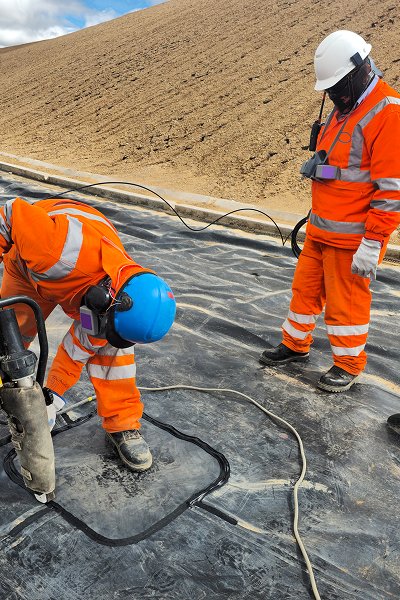Definition of geomembrane
The anti-seepage material made of geomembrane (such as HDPE, LLDPE, PVC, etc.) has excellent sealing and chemical corrosion resistance. Its main purpose is to block the penetration of liquids and is often used in anti-seepage layers, sealing layers, etc.

Definition of geotextile
Geotextile is a permeable geosynthetic material made of short fibers or filaments through needle punching or heat sealing. Its functions mainly include reinforcement, isolation, filtration and drainage.

Performance comparison details
Impermeability
Geomembranes have extremely low water permeability (usually <10⁻¹⁴ cm/s), and play a key role in projects such as landfills, artificial lake bottoms, and anti-seepage pools.
Geotextiles are not designed specifically for anti-seepage, but have good permeability and are suitable for environments that require filtration or drainage.
Mechanical properties
Geomembranes have high tensile strength and good ductility, especially HDPE membranes that can maintain integrity under stretching conditions;
Geotextiles have certain tensile strength, but their advantages lie in puncture resistance and flexibility, and are suitable for irregular foundations.
Chemical corrosion resistance
Geomembranes can resist a variety of chemicals such as acids, alkalis, oils, and salts, and are particularly suitable for scenes such as chemical pools and sewage pools;
Geotextiles have slightly weaker corrosion resistance, and may age and deteriorate if exposed to sunlight or chemical environments for a long time.
Functional comparison
Impermeability function (core function)
The most important function of geomembrane is impermeability, and its airtightness can effectively prevent the penetration of liquids or gases. Its typical applications include:
Landfill lining system to prevent leachate from polluting groundwater;
Impermeability layer at the bottom of reservoirs, artificial lakes, and water storage tanks;
Impermeability control of industrial sewage pools and oil depots.
The impermeability performance of geomembranes depends on factors such as its material type (such as HDPE, LLDPE), thickness, and construction welding quality. Taking HDPE membrane as an example, its permeability coefficient can be as low as 10⁻¹⁴ cm/s, which is almost impermeable.
Functional analysis of geotextiles
Unlike geomembranes that "block" liquid penetration, the function of geotextiles is more of a "guidance" or "enhancement":
Filtration function (one of the core applications)
Geotomes are permeable to water but not to soil, and can effectively filter out fine soil particles while allowing water to flow through. Typical uses include:
Dykes and river filter layers;
Filter layers for drainage ditches, slopes, and tunnels;
Underground drainage pipe wrapping layer to prevent siltation.
Drainage function (combined with filtration function)
In permeable soil layers or underground structures, geotextiles can be used as horizontal or vertical drainage channels to effectively drain accumulated water and prevent water accumulation inside the structure from causing pressure increases or slippage problems. For example:
Drainage protection layers for subways and basements;
Vertical drainage wells and drainage belts outside underground culverts;
Drainage systems in roof greening.



